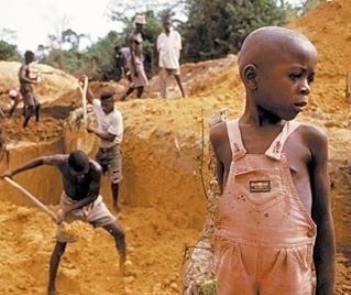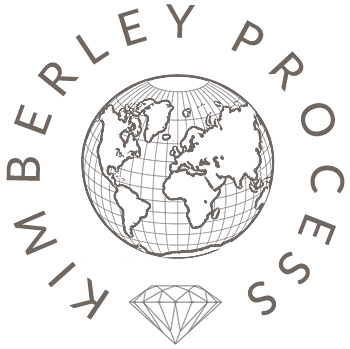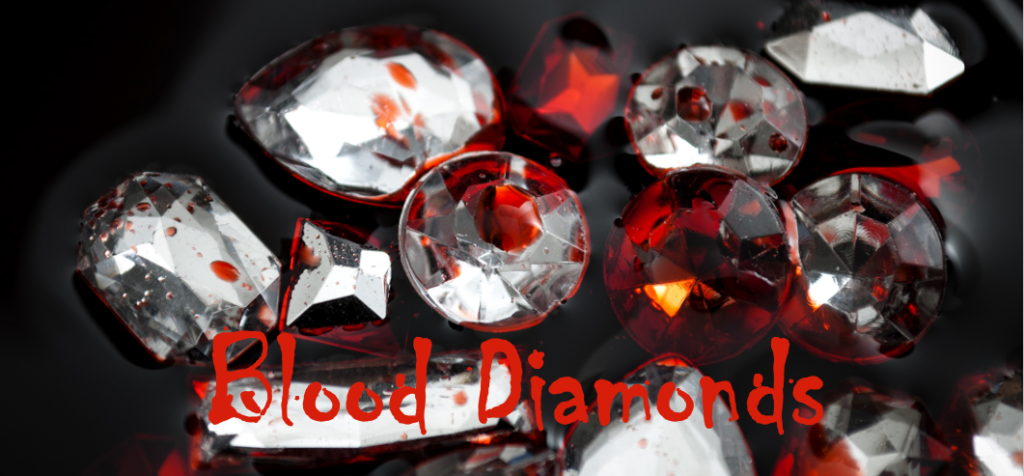“A stone so rare, men will do anything to possess it and all who touch it are left with blood on their hands”. If you are familiar with this quote then I’m sure you have seen the Leonardo DiCaprio drama, Blood Diamond. This movie is a representation of the conflicts that arose in areas of Africa due to the lucrative nature of mining blood diamonds, or conflict diamonds. The United Nations defines blood diamonds as diamonds that are mined in areas controlled by groups that are opposed to the recognized government in that country. Warlords in these countries enslave their own countrymen to mine diamonds. This results in horrible human rights abuse and extraordinarily violent wars. All of this violence and death is how the term, “blood diamonds” and “conflict diamonds” were coined.
What Are Blood Diamonds?
History
The 1990s are an important period in the history of blood diamonds and how this negative term was coined. During this time, brutal civil wars were breaking out in different parts of western and central Africa, specifically, Angola, The Democratic Republic of the Congo and Sierra Leone. These specific conflicts focused the world’s attention to the destructive role of diamonds, although these same conflicts were occurring in other countries as well. During this time, rough diamonds mined in rebel-controlled areas were sold directly to diamond traders or were smuggled into neighboring countries. They were then merged into the supply of legitimately mined diamonds and then sold on the open market. Profits from these diamond sales were used to buy weapons for these rebel groups. The rebel groups organized extremely violent campaigns that brought tragedy to innocent civilians.

There is virtually no way to determine a conflict diamond from a legitimately mined diamond after it enters the processing stream. All diamonds are cut and polished by the same companies and brought to the consumer market. For this reason, worldwide concern grew over these gemstones entering the markets in the West because purchasers were unable to decipher conflict diamonds from legitimate diamonds. At this time there was no process to track the origin of diamonds. On the other hand, diamond traders became worried that growing insurgence against blood diamonds might lead to a boycott of all the gems. To their fear, the United Nations (UN) Security Council issued a report in 2000 on the status of conflict diamonds in world markets. The report specifically criticized De Beers Consolidated Mines, Ltd., (the company that controlled roughly 60 percent of the global trade in rough diamonds at the time) and the world’s largest diamond market in Antwerp, Belgium, for not verifying the origin of the diamonds traded there. Because of this, trade associations joined human rights groups and the UN in establishing the Kimberley Process.
You might be thinking, “isn’t this supposed to be a diamond blog to help me find a ring for my fiancé? Why are you giving me a history lesson? Keep politics out of it”. I understand, but I believe that it is important to educate people on the struggle, heart ache and destruction that these wars caused and make sure that we are not supporting this dark side of the diamond industry.
What is the Kimberly Process?
The Kimberley Process is a certification process that began in 2003 with the goal to prevent diamond mining from funding political conflict. Ideally, countries that are a part of The Kimberley Process are supposed to self-regulate and trade only with other countries that identify with the program. Some argue that the program is ineffective because there is no true enforcement. Another downfall to The Kimberley Process is that it doesn’t address the serious issues of child labor and environmental destruction from diamond mining. Others have concerns that The Kimberley Process’ definition of “conflict diamonds” is too vague to be effective. However, this certification scheme does impose extensive requirements on its members and enables them to certify shipments of rough diamonds as “conflict-free”. This prevents conflict diamonds from entering the legitimate trade. The terms of The Kimberley Process state that its members have to meet “minimum requirements” and put in place national legislation. These requirements and legislations mandate that institutions regulate exports and imports through internal controls and commit to transparency and the exchange of statistical data. Members can only legally trade with other participants who have also met the minimum requirements. Also, international shipments of rough diamonds (unpolished diamonds) must have a Kimberley Process certificate guaranteeing that they are conflict-free.

The Diamond Development Initiative
Another great organization that works to combat the mining and trade of blood diamonds is The Diamond Development Initiative (DDI). The DDI was created in 2005 to address the social and economic issues faced by diamond miners in Africa and South America. The organization works to help those who live in poverty and are vulnerable to health and safety risks, exploitation and human rights abuses in these areas. The DDI works to reshape small-scale diamond mining into an economically feasible, socially and environmentally responsible activity. “It provides miners with access to the opportunities, information and tools they need to work with dignity as valued actors in the responsible supply chain and as contributors to their community’s development” (ddiglobal.org). This organization also works to fill the gaps in the Kimberley Process by responding to issues of poverty and exploitation with development solutions.
How to Avoid Buying Blood Diamonds
Conflict Free Diamonds
At this point you might be thinking, “okay, I obviously don’t want to support such a terrible process of mining diamonds, after all, I’m a gentleman, but how do I find out if the diamond I am looking to buy is a blood diamond, or not?” Don’t worry, I have helpful tips that you can follow below.
The first thing you can do is research reputable jewelers or utilize the list that I posted below. Find a jeweler you trust and make sure that they specialize in conflict-free diamonds and jewelry in general. You might want to consider jewelers who fund projects in the areas that the diamonds are mined, ethically sources their diamonds and supports the Diamond Development Initiative.
The next thing you want to do is to ask the jeweler where their diamonds are mined. They should be able to tell you about every step of the process starting with where the diamond is mined all the way to how it ends up in the jewelry store. You want to know where the diamond comes from and under what conditions it was mined. If the jeweler doesn’t know or tries to assure you the diamond is fine without answering your question, this could be a red flag and you might want to find a more honest jeweler to purchase your diamond from. Even if the jeweler tells you that the diamond is certified by the Kimberley Process or, “came from a reputable source”, you may want to keep asking questions until you get a response that you’re satisfied with. Many diamond companies advertise that their diamonds are fairly traded, so it is important to ask if they are certified.
Next, The Kimberley Process is a good certification to note when searching from conflict free diamonds, but it is important to be mindful of the limits to the process.
A great tip to finding a conflict free diamond is to avoid buying a diamond that was mined in areas of conflict. Seems self-explanatory, right? There are multiple human rights agencies such as Amnesty International that have documented human rights abuse in several countries that mine diamonds. You can avoid purchasing diamonds that were mined in these countries and other countries where diamond mining funds warfare and violence. To name a few, do not buy diamonds that have been mined in Zimbabwe, Angola, Democratic Republic of Congo, Côte d’Ivoire, and Liberia. Instead, you can purchase a diamond from countries where human rights are protected and environmental standards are followed such as: Canada, Namibia, Botswana, and Sierra Leone.
Another great tip to avoiding conflict diamonds is to shop for vintage or antique diamonds. Also, if you have a family heirloom diamond, but don’t like the setting or style, you can take it to a jeweler and they can usually reset or re-cut the diamond and create a new setting or design to your preference. The downfall to this is that you may not know where the antique or vintage diamond was mined and may not have a way of finding out. However, you will be avoiding supporting current abuses and blood diamond mining in the diamond industry.
Conflict Free Gold
Although I focus on information about diamonds in this blog, you do not want to spend all this time finding a conflict free diamond and come to find out that the gold that the diamond is set in is conflicted. Make sure to also check the source of the gold in the setting of your engagement ring. Unfortunately, some current gold mining practices can be environmentally destructive and subject to mercury and cyanide, which are extremely poisonous. You can ensure the health of the workers and the environment by choosing recycled gold. Another option is to purchase fair trade gold to ensure ethical mining practices worldwide. Again, you need to ask your jeweler where the gold is mined in the same way as you did with the diamonds.
Conclusion
Since the 1990s and early 2000s, the worst of the African civil wars have ended. It is said that the share of blood diamonds in the global diamond trade fell from as much as 15 percent in the 1990s to less than 1 percent by 2010.
However, some human rights activists have claimed that these percentages may be skewed because they only reflect the UN’s specific definition of blood diamonds (gems that fund rebellion against a country’s government) and leave out human rights conditions and environmental impact. Even in countries certified as conflict-free, it is possible for corrupt officials to use their control over illegal diamond operations to benefit themselves or preserve their power at the expense of diamond miners. These workers can be denied basic human rights and treated with violence. This abuse of the legitimate diamond trade is prompting protests to redefine blood diamonds as, “gems whose trade is based on aggression or violence of any kind”. This redefinition would expand the campaign against blood diamonds and fight mining conditions in countries where basic human rights are denied.
With that being said, as gentlemen, we can all do our part to make an effort to purchase only conflict free diamonds when finding the perfect ring for our fiancé and make sure that this trade becomes more ethical every day.
As noted above, the best thing you can do is research and inquire with different jewelers in their process to find out if the diamond you are purchasing is conflict free.
You can find a list of conflict free diamond brands below:

